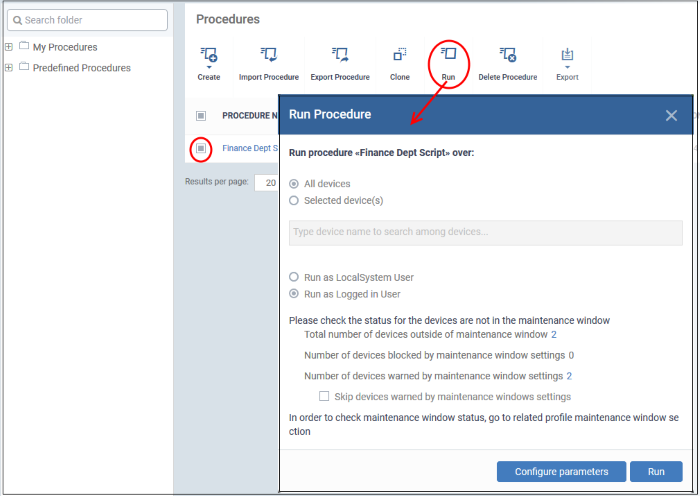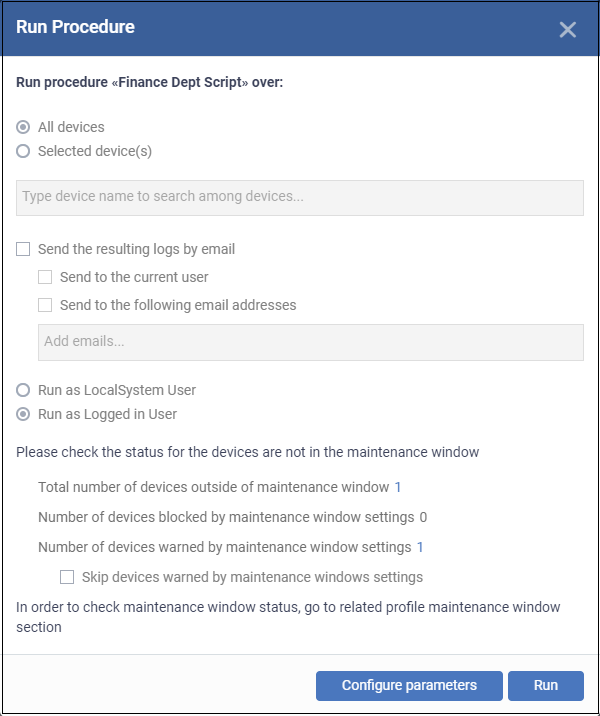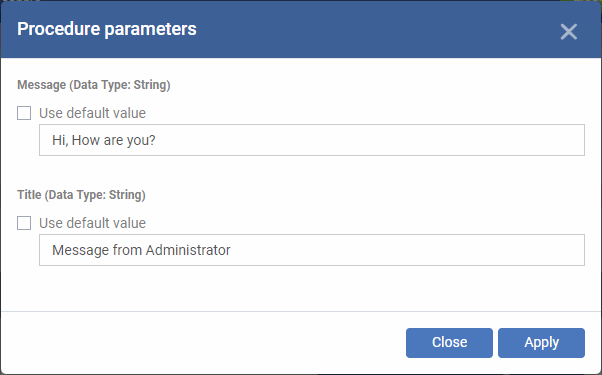Apply Procedures to Devices
There are six ways you can run procedures on devices:
- Device list - Click ‘Devices’ > ‘Device List’ > select target devices > Click ‘Run Procedure’
- Schedule in a profile - Click ‘Configuration Templates’ > ‘Profiles’ > click on a profile name > Click ‘Add Profile Section’ > ‘Procedures’
- On users - Click ‘Users’ > ‘User List’ > select target users > Click ‘Run Procedure’
- On user groups – Click ‘Users’ > ‘User Group’ > select target groups > Click ‘Run Procedure’
- On customer groups – Click ‘Devices’ > ‘Device List’ > select customer groups in the middle column > Click ‘Run Procedure’
For Windows devices, make sure patch management setting is disabled to execute patches.
Run a procedure
- Click 'Configuration Templates' > 'Procedures'
- Browse the folder tree to locate the procedure you want to run
- Select the procedure and click 'Run' at the top. Note - only approved procedures can be applied. You can also run only one procedure at a time.

Choose the execution options from the 'Run Procedure' dialog
- All Devices - The procedure is applied to every device which matches its target operating system.
- Selected Device(s) - Type the name of a device and select it from the list. You can add multiple devices in the field.

Send the resulting logs by email - Script procedures only.
- Send to current user - Procedure results are sent to the admin who is currently logged into Endpoint Manager.
- Send to the following email addresses - Add email addresses to whom log results should be sent.
Run as Local System User / Run as Logged in user - Choose the user account under which the procedure should run on target devices. Note - this option is not available for patch procedures.
Maintenance window status - A maintenance window is a set time-slot reserved for running procedures. This section show details about any maintenance windows in the profiles of target devices.
- Total number of devices outside of maintenance window - The number of devices that are not part of a maintenance window. The procedure can run on these devices.
- Number of devices blocked by maintenance windows settings - The number of devices on which you cannot run the procedure because the admin has blocked procedures outside the maintenance window.
- Number of devices warned by maintenance window settings - The number of devices that are part of a maintenance window and have warnings enabled. You can still run the procedure on these devices.
- Skip devices warned by maintenance windows settings - A maintenance window is a time-slot reserved for running important tasks on target devices. Admins can enable a warning if somebody attempts to run a procedure outside of the window. This setting will skip those devices which have been added to a maintenance window with warnings enabled.
- Click 'Configure Parameters' to view and edit the variables
- The fields are pre-populated with their default values:

- Enter the value for each parameter in the respective text box
- Select 'Use default value' if you want to keep the original.
- Click 'Apply'
|
Tip: You can skip this step If you want to use default values for all parameters. For more info on default values, see Create a Custom Procedure. |
-
Click the 'Run' button in the 'Run Procedure' dialog.
|
Important Note: Patches that are hidden by administrators will not be executed. See 'Manage OS Patches on Windows Endpoints' for more details. |



